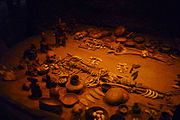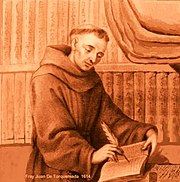Portal:Mesoamerica
Mesoamerica (Spanish: Mesoamérica) is a region and cultural area in the Americas, extending approximately from central Mexico to Belize, Guatemala, El Salvador, Honduras, Nicaragua, and Costa Rica, within which a number of pre-Columbian societies flourished before the Spanish colonization of the Americas in the 15th and 16th centuries.
As a cultural area, Mesoamerica is defined by a mosaic of cultural traits developed and shared by its indigenous cultures. Beginning as early as 7000 BC the domestication of maize, beans, squash and chili, as well as the turkey and dog, caused a transition from paleo-Indian hunter-gatherer tribal grouping to the organization of sedentary agricultural villages. In the subsequent formative period, agriculture and cultural traits such as a complex mythological and religious tradition, a vigesimal numeric system, and a complex calendric system, a tradition of ball playing, and a distinct architectural style, were diffused through the area. Also in this period villages began to become socially stratified and develop into chiefdoms with the development of large ceremonial centers, interconnected by a network of trade routes for the exchange of luxury goods such as obsidian, jade, cacao, cinnabar, Spondylus shells, hematite, and ceramics. While Mesoamerican civilization did know of the wheel and basic metallurgy, neither of these technologies became culturally important.
Among the earliest complex civilizations was the Olmec culture which inhabited the Gulf coast of Mexico. In the Preclassic period, complex urban polities began to develop among the Maya and the Zapotecs. During this period the first true Mesoamerican writing systems were developed in the Epi-Olmec and the Zapotec cultures, and the Mesoamerican writing tradition reached its height in the Classic Maya Hieroglyphic script. Mesoamerica is one of only five regions of the world where writing was independently developed. In Central Mexico, the height of the Classic period saw the ascendancy of the city of Teotihuacan, which formed a military and commercial empire whose political influence stretched south into the Maya area and northward. During the Epi-Classic period the Nahua peoples began moving south into Mesoamerica from the North. During the early post-Classic period Central Mexico was dominated by the Toltec culture, Oaxaca by the Mixtec, and the lowland Maya area had important centers at Chichén Itzá and Mayapán. Towards the end of the post-Classic period the Aztecs of Central Mexico built a tributary empire covering most of central Mesoamerica.
Selected article

The Western Mexico shaft tomb tradition or shaft tomb culture refers to a set of interlocked cultural traits found in the western Mexican states of Jalisco, Nayarit, and, to a lesser extent, Colima to its south, roughly dating to the period between 300 BCE and 400 CE, although there is not wide agreement on this end-date. Nearly all of the artifacts associated with this shaft tomb tradition have been discovered by looters and are without provenance, making dating problematic. The first major undisturbed shaft tomb associated with the tradition was not discovered until 1993, at Huitzilapa, Jalisco.
Originally regarded as of Tarascan origin, contemporary with the Aztecs, it became apparent in the middle of the 20th century, as a result of further research, that the artifacts and tombs were instead over 1000 years older. Until recently, the looted artifacts were all that was known of the people and culture or cultures that created the shaft tombs. So little was known, in fact, that a major 1998 exhibition highlighting these artifacts was subtitled: "Art and Archaeology of the Unknown Past".
It is now thought that, although shaft tombs are widely diffused across the area, the region was not a unified cultural area. Archaeologists, however, still struggle with identifying and naming the ancient western Mexico cultures of this period.
Selected biography

Juan de Torquemada (c. 1562 – 1624) was a Franciscan friar, missionary and historian in Spanish colonial Mexico, and is considered the "leading Franciscan chronicler of his generation." He is most famous for his monumental history of the indigenous peoples entitled Los veinte y un libros rituales y Monarquía indiana, commonly known as Monarquía indiana ("Indian Monarchy"), published initially in Spain in 1615 with a license obtained by Torquemada. Monarquia Indiana was the "prime text of Mexican history, and was destined to influence all subsequent chronicles until the twentieth century." The fact that it was republished a century later in 1723, in what has been considered the standard edition, is an indication of its importance. It was used by later historians, the Franciscan Augustin de Vetancurt and most importantly by eighteenth-century Jesuit Francisco Javier Clavijero.
Juan de Torquemada was born at Torquemada, Palencia, sometime between 1557 and 1565, with few firm data on his life, with much coming from his own work. He arrived in New Spain as a child and grew up in Mexico City. He studied philosophy and Nahuatl at the convent Grande de San Francisco in Mexico City, studying under Fray Juan Bautista and Antonio de Valeriano, an indigenous graduate of the colegio who taught him Nahuatl. He was ordained sometime between 1579 and 1583. In 1582 he moved to the convent of Santiago Tlatelolco, and he was made guardian of that convent in 1600. He also took over the administration of the Colegio de Santa Cruz de Tlatelolco.
Did you know?
- ... that the archaeological site of Topoxte (pictured) has the best surviving example of Postclassic Maya architecture in the Petén region of Guatemala?
Subcategories
Related portals
Selected image
 |
Olmec colossal stone heads are realistic portraits of living (or recently deceased) rulers. Each head is distinct and naturalistic, displaying individualised features.
Featured articles
Good Topics
Good articles
 Gómez de Alvarado
Gómez de Alvarado Aztecs
Aztecs La Blanca, Peten
La Blanca, Peten Calakmul
Calakmul Bartolomé de las Casas
Bartolomé de las Casas Copán
Copán El Chal
El Chal Haʼ Kʼin Xook
Haʼ Kʼin Xook History of chocolate
History of chocolate Itzam Kʼan Ahk II
Itzam Kʼan Ahk II Iximche
Iximche Kʼinich Yat Ahk II
Kʼinich Yat Ahk II Kʼinich Yoʼnal Ahk I
Kʼinich Yoʼnal Ahk I Macuahuitl
Macuahuitl Maize
Maize Manche Chʼol
Manche Chʼol Mixco Viejo
Mixco Viejo Motul de San José
Motul de San José Mundo Perdido, Tikal
Mundo Perdido, Tikal North Acropolis, Tikal
North Acropolis, Tikal Potbelly sculpture
Potbelly sculpture William H. Prescott
William H. Prescott Qʼumarkaj
Qʼumarkaj Resplendent quetzal
Resplendent quetzal Seibal
Seibal Serpent labret with articulated tongue
Serpent labret with articulated tongue Spanish conquest of Yucatán
Spanish conquest of Yucatán Spanish conquest of Chiapas
Spanish conquest of Chiapas Spanish conquest of El Salvador
Spanish conquest of El Salvador Spanish conquest of Honduras
Spanish conquest of Honduras Spanish conquest of the Maya
Spanish conquest of the Maya Tikal
Tikal Toniná
Toniná Western Mexico shaft tomb tradition
Western Mexico shaft tomb tradition Benjamin Lee Whorf
Benjamin Lee Whorf Yoʼnal Ahk III
Yoʼnal Ahk III Zaculeu
Zaculeu
Topics
WikiProjects
New articles
Rules | Match log | Results page (for watching) | Last updated: 2024-12-20 21:11 (UTC)
Note: The list display can now be customized by each user. See List display personalization for details.
- La Bartola (edit | talk | history | links | watch | logs | tools) by Dtmich24 (talk · contribs · new pages (17)) started on 2024-12-20, score: 28
- Jaime Calderón Calderón (edit | talk | history | links | watch | logs | tools) by JNOJ1423 (talk · contribs · new pages (3)) started on 2024-12-18, score: 36
- Spanish period of Belize (edit | talk | history | links | watch | logs | tools) by Asdfjrjjj (talk · contribs · new pages (14)) started on 2024-12-08, score: 194
- Postclassic period in Belize (edit | talk | history | links | watch | logs | tools) by Asdfjrjjj (talk · contribs · new pages (14)) started on 2024-12-06, score: 154
- Miss International 1972 (edit | talk | history | links | watch | logs | tools) by Ky01535 (talk · contribs · new pages (38)) started on 2024-12-17, score: 24
- Juan Sabines (edit | talk | history | links | watch | logs | tools) by Moscow Mule (talk · contribs · new pages (46)) started on 2024-12-16, score: 28
- Lepidostroma vilgalysii (edit | talk | history | links | watch | logs | tools) by Esculenta (talk · contribs · new pages (47)) started on 2024-12-15, score: 28
- Witzinah (edit | talk | history | links | watch | logs | tools) by Juan g. regino (talk · contribs · new pages (3)) started on 2024-12-15, score: 40
- Yamil Lu'um (edit | talk | history | links | watch | logs | tools) by Juan g. regino (talk · contribs · new pages (3)) started on 2024-12-14, score: 60
- HOSLAC: History of Science in Latin America and the Carribean (edit | talk | history | links | watch | logs | tools) by Ragesoss (talk · contribs · new pages (1)) started on 2024-12-13, score: 30
- La conquista la hicieron los indios y la independencia los españoles (edit | talk | history | links | watch | logs | tools) by Baal Nautes (talk · contribs · new pages (7)) started on 2024-12-13, score: 66
- Port of Progreso (edit | talk | history | links | watch | logs | tools) by Fob.schools (talk · contribs · new pages (4)) started on 2024-12-09, score: 30
- X'baatún (edit | talk | history | links | watch | logs | tools) by Juan g. regino (talk · contribs · new pages (3)) started on 2024-12-06, score: 74
- Ukit Kan Lek Tokʼ (edit | talk | history | links | watch | logs | tools) by Arqueogato (talk · contribs · new pages (1)) started on 2024-12-06, score: 72
Associated Wikimedia
The following Wikimedia Foundation sister projects provide more on this subject:
-
Commons
Free media repository -
Wikibooks
Free textbooks and manuals -
Wikidata
Free knowledge base -
Wikinews
Free-content news -
Wikiquote
Collection of quotations -
Wikisource
Free-content library -
Wikiversity
Free learning tools -
Wiktionary
Dictionary and thesaurus

























